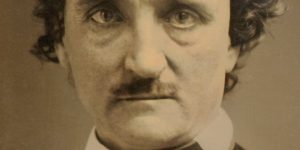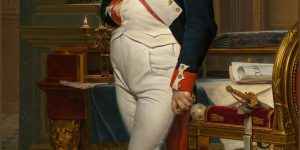To Isadore Poem by Edgar Allan Poe
I
Beneath the vine-clad eaves,
Whose shadows fall before
Thy lowly cottage door—
Under the lilac’s tremulous leaves—
Within thy snowy clasped hand
The purple flowers it bore.
Last eve in dreams, I saw thee stand,
Like queenly nymph from Fairy-land—
Enchantress of the flowery wand,
Most beauteous Isadore!
II
And when I bade the dream
Upon thy spirit flee,
Thy violet eyes to me
Upturned, did overflowing seem
With the deep, untold delight
Of Love’s serenity;
Thy classic brow, like lilies white
And pale as the Imperial Night
Upon her throne, with stars bedight,
Enthralled my soul to thee!
III
Ah! ever I behold
Thy dreamy, passionate eyes,
Blue as the languid skies
Hung with the sunset’s fringe of gold;
Now strangely clear thine image grows,
And olden memories
Are startled from their long repose
Like shadows on the silent snows
When suddenly the night-wind blows
Where quiet moonlight lies.
IV
Like music heard in dreams,
Like strains of harps unknown,
Of birds for ever flown,—
Audible as the voice of streams
That murmur in some leafy dell,
I hear thy gentlest tone,
And Silence cometh with her spell
Like that which on my tongue doth dwell,
When tremulous in dreams I tell
My love to thee alone!
V
In every valley heard,
Floating from tree to tree,
Less beautiful to me,
The music of the radiant bird,
Than artless accents such as thine
Whose echoes never flee!
Ah! how for thy sweet voice I pine:—
For uttered in thy tones benign
(Enchantress!) this rude name of mine
Doth seem a melody!
Note on To Isadore etc. from Edgar Allan Poe’s Complete Poetical Works by John H. Ingram
Whilst Edgar Poe was editor of the Broadway Journal, some lines “To Isadore” appeared therein, and, like several of his known pieces, bore no signature.
They were at once ascribed to Poe, and in order to satisfy questioners, an editorial paragraph subsequently appeared, saying they were by “A. Ide, junior.”
Two previous poems had appeared in the Broadway Journal over the signature of “A. M. Ide,” and whoever wrote them was also the author of the lines “To Isadore.” In order, doubtless, to give a show of variety, Poe was then publishing some of his known works in his journal over noms de plume, and as no other writings whatever can be traced to any person bearing the name of “A. M. Ide,” it is not impossible that the poems now republished in this collection may be by the author of “The Raven.”
Having been published without his usual elaborate revision, Poe may have wished to hide his hasty work under an assumed name.
The three pieces (To Isadore Poem, The Village Street Poem, and The Forest Reverie Poem) are included in the present collection, so the reader can judge for himself what pretensions they possess to be by the author of “The Raven.”



